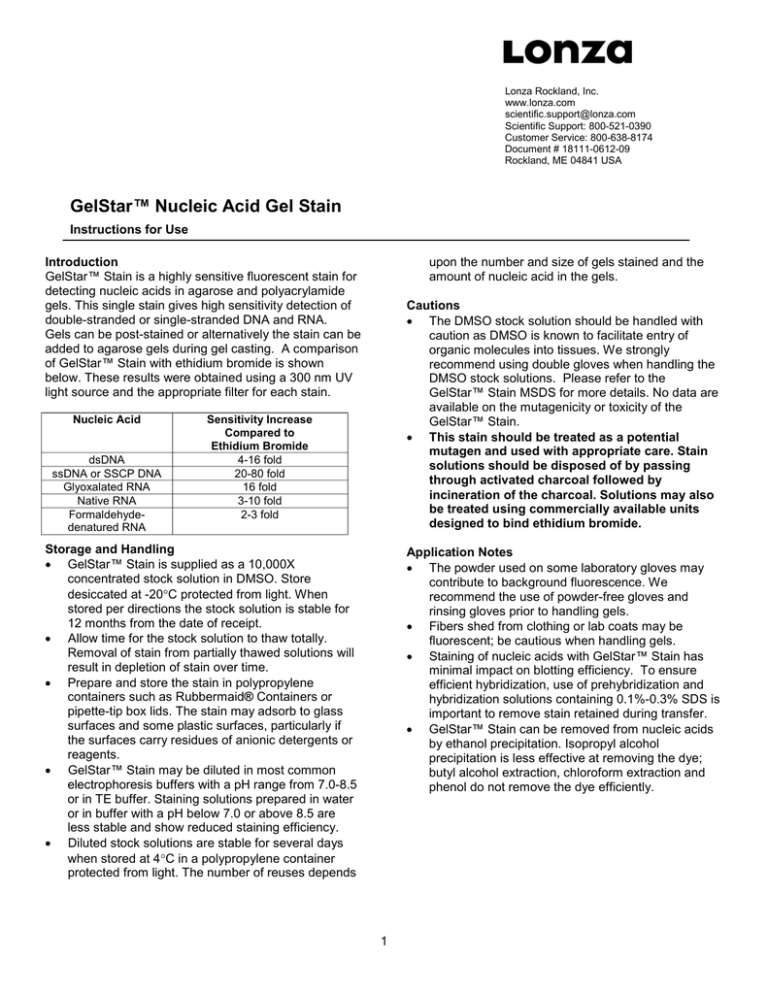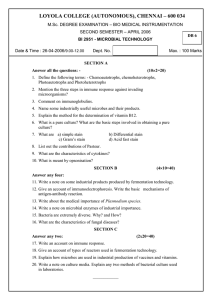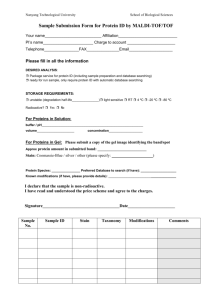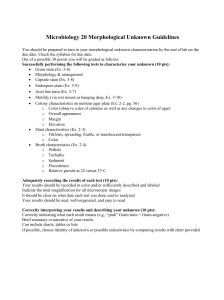
Lonza Rockland, Inc.
www.lonza.com
scientific.support@lonza.com
Scientific Support: 800-521-0390
Customer Service: 800-638-8174
Document # 18111-0612-09
Rockland, ME 04841 USA
GelStar™ Nucleic Acid Gel Stain
Instructions for Use
Introduction
GelStar™ Stain is a highly sensitive fluorescent stain for
detecting nucleic acids in agarose and polyacrylamide
gels. This single stain gives high sensitivity detection of
double-stranded or single-stranded DNA and RNA.
Gels can be post-stained or alternatively the stain can be
added to agarose gels during gel casting. A comparison
of GelStar™ Stain with ethidium bromide is shown
below. These results were obtained using a 300 nm UV
light source and the appropriate filter for each stain.
Nucleic Acid
dsDNA
ssDNA or SSCP DNA
Glyoxalated RNA
Native RNA
Formaldehydedenatured RNA
upon the number and size of gels stained and the
amount of nucleic acid in the gels.
Cautions
• The DMSO stock solution should be handled with
caution as DMSO is known to facilitate entry of
organic molecules into tissues. We strongly
recommend using double gloves when handling the
DMSO stock solutions. Please refer to the
GelStar™ Stain MSDS for more details. No data are
available on the mutagenicity or toxicity of the
GelStar™ Stain.
• This stain should be treated as a potential
mutagen and used with appropriate care. Stain
solutions should be disposed of by passing
through activated charcoal followed by
incineration of the charcoal. Solutions may also
be treated using commercially available units
designed to bind ethidium bromide.
Sensitivity Increase
Compared to
Ethidium Bromide
4-16 fold
20-80 fold
16 fold
3-10 fold
2-3 fold
Storage and Handling
• GelStar™ Stain is supplied as a 10,000X
concentrated stock solution in DMSO. Store
desiccated at -20°C protected from light. When
stored per directions the stock solution is stable for
12 months from the date of receipt.
• Allow time for the stock solution to thaw totally.
Removal of stain from partially thawed solutions will
result in depletion of stain over time.
• Prepare and store the stain in polypropylene
containers such as Rubbermaid® Containers or
pipette-tip box lids. The stain may adsorb to glass
surfaces and some plastic surfaces, particularly if
the surfaces carry residues of anionic detergents or
reagents.
• GelStar™ Stain may be diluted in most common
electrophoresis buffers with a pH range from 7.0-8.5
or in TE buffer. Staining solutions prepared in water
or in buffer with a pH below 7.0 or above 8.5 are
less stable and show reduced staining efficiency.
• Diluted stock solutions are stable for several days
when stored at 4°C in a polypropylene container
protected from light. The number of reuses depends
Application Notes
• The powder used on some laboratory gloves may
contribute to background fluorescence. We
recommend the use of powder-free gloves and
rinsing gloves prior to handling gels.
• Fibers shed from clothing or lab coats may be
fluorescent; be cautious when handling gels.
• Staining of nucleic acids with GelStar™ Stain has
minimal impact on blotting efficiency. To ensure
efficient hybridization, use of prehybridization and
hybridization solutions containing 0.1%-0.3% SDS is
important to remove stain retained during transfer.
• GelStar™ Stain can be removed from nucleic acids
by ethanol precipitation. Isopropyl alcohol
precipitation is less effective at removing the dye;
butyl alcohol extraction, chloroform extraction and
phenol do not remove the dye efficiently.
1
Before You Begin
Detection of DNA and RNA in Agarose gels by
Post-Staining
1. Separate the samples by electrophoresis as normal.
2. Remove GelStar™ Stain from -20°C storage and
thaw at room temperature for 10 to 20 minutes.
3. Spin the stain vial briefly in a microcentrifuge to
deposit the solution in the bottom of the vial.
4. Dilute stock GelStar™ Stain in buffer in a
polypropylene container.
Use a polypropylene container for diluting the stain
and staining the gel
Use a 302 or 312 nm UV transilluminator or a bluelight transilluminator such as the Clare Chemical
Dark Reader® Transilluminator for dye excitation
Use a GelStar™ Filter for photography
For DNA:
Dilute in TE, TAE, or TBE
to give a final
concentration of 1X, e.g.,
5 µl of stain stock added
to each 50 ml of buffer
Detection of DNA or RNA in Agarose Gels by
Pre-staining
1. Remove GelStar™ Stain from -20°C storage and
thaw at room temperature for 10 to 20 minutes.
2. Spin the stain vial briefly in a microcentrifuge to
deposit the solution in the bottom of the vial.
3. Prepare the gel solution and cool the agarose
solution to 55°C-65°C.
4. Add a volume of stock GelStar™ Stain to the
tempered gel solution as indicated below:
For DNA:
For RNA:
Use a final concentration
of 1X e.g., 5 µl of stain
stock added to each
50 ml of gel solution.
Use a final concentration
of 2X, e.g., 10 µl of stain
stock added to each 50 ml
of gel solution.
For RNA:
Dilute stock GelStar™ Stain in 1X
MOPS buffer to give a final
concentration of 2X, e.g., 10 µl of
stain stock added to each 50 ml of
buffer.
5. Prepare enough stain solution to cover the gel
during staining.
6. Mix the stain solution to distribute the stain
thoroughly into the solution.
7. Place the gel and the stain solution in a
polypropylene container and incubate with gentle
agitation. Protect from direct exposure to strong light
during staining. Staining is normally complete within
30 minutes. Exceptionally thick gels (>4 mm) or high
concentration gels may require longer staining times
for optimal results.
8. Visualize the results by photography, scanning, or
image capture as described, on next page. No
destaining is normally required, although we
recommend a brief rinse with buffer to minimize
deposition of stain on work surfaces.
5. Mix the gel solution by swirling, stirring, or inversion
to thoroughly distribute the stain into the gel solution.
6. Immediately cast the gel and allow to solidify.
Avoid extended light exposure and extended
exposure (>10 min.) to a buffer overlay.
7. Run the gel using your standard protocol.
8. Visualize the results by photography, scanning, or
image capture as described, on next page. No
destaining is normally required, although we
recommend a brief rinse with buffer to minimize
deposition of stain on work surfaces.
NOTES:
• GelStar™ Stain is compatible with post-staining of
DNA in agarose gels >4 mm thick, such as Lonza
Reliant™ Precast Agarose Gels.
• GelStar™ Stain gives excellent detection of RNA
that has not been denatured, as well as RNA
denatured by a variety of methods, e.g., glyoxal,
formamide, or formaldehyde. The increase in
detection sensitivity in comparison to ethidium
bromide staining varies depending upon the sample
and gel preparation methods used (see note below
and Table on page 1).
• Detection of glyoxalated RNA with GelStar™ Stain is
optimal in gels that are ≤4 mm thick. To see the full
sensitivity enhancement of GelStar™ Stain, use gels
of this thickness or include the stain in the gel for
detection.
NOTES:
• The effect of GelStar™ Stain on DNA migration is
smaller compared to ethidium bromide, i.e., DNA
migration is slower compared to gels with no stain
added.
• GelStar™ Stain is sensitive to the presence of
particulates in the gel buffer and dust/debris on gel
trays. For optimal results, filter the buffer used to
prepare the gel solution.
• Including GelStar™ Stain in vertical gels is not
recommended as the dye may bind to glass or
plastic plates.
2
Excitation of GelStar™ Stained Nucleic Acids
Detection of Nucleic Acids on Vertical Gels by PostStaining
1. Separate the samples by electrophoresis as normal.
2. Remove GelStar™ Stain from -20°C storage and
thaw at room temperature for 10 to 20 minutes.
3. Spin the stain vial briefly in a microcentrifuge to
deposit the solution in the bottom of the vial.
4. Add stock GelStar™ Stain to buffer (TE, TAE,
MOPS, or TBE) to give a final concentration of 1X,
e.g., 5 µl of stain stock added to each 50 ml of
buffer. Prepare enough stain solution to cover the
surface of the gel during staining.
5. Mix the stain solution by swirling, stirring, or
inversion to distribute the stain thoroughly into the
solution.
6. Open the cassette, and leave the gel in place on one
plate.
7. Place the plate, gel side up, in a staining container.
8. Gently pour the stain over the surface of the gel; a
disposable pipette may be used to help distribute the
stain evenly over the gel surface. Do not submerge
the gel and plate in staining solution.
9. Incubate for 30 minutes. No destaining is required,
although we recommend a brief rinse with buffer to
minimize deposition of stain on work surfaces.
10. Visualize the results by photography, scanning, or
image capture as described above. For highest
sensitivity the gel should be carefully removed from
the plate and placed directly on the transilluminator
or scanning stage. Alternatively, if a relatively low
fluorescence plate is used, the results may be
visualized by placing the gel and plate gel side down
on the transilluminator and photographing or by
scanning the gel directly on the plate.
Either:
Illuminate the gel with a standard UV transilluminator
(302 or 312 nm).
Or:
Illuminate the gel with a blue-light transilluminator such
as the Clare Chemical Dark Reader® Transilluminator .
Or:
Excite the GelStar™ Stain with an argon laser scanning
system. Systems compatible with the detection of
SYBR® Green Stain should also be compatible with
GelStar™ Stain.
Visualization by Photography
Photograph the gel with the filter and film in the table
below. Polaroid® type 55 positive/negative film can be
used for photography of gels having relatively strong
signals.
Exposure time varies with the strength of the
illumination source and the filter used for photography.
Suggested Exposure Conditions For Different Film
Types.
Film
Type 57
or 667
Type 55
f-stop
Filter
Exposure
4.5
GelStar™ Filter
2-5 seconds
4.5
GelStar™ Filter
15-45
seconds
Visualization by Image Capture systems
GelStar™ Stain is compatible with most CCD and video
imaging systems. Due to variations in the filters for
these systems you may need to purchase a new filter.
Lonza does not sell filters for this type of camera.
Contact your systems manufacturer and using the
excitation and emission information listed they can guide
you to an appropriate filter. The excitation and emission
maxima of GelStar™ Stain are 493 nm and 527 nm (532
nm for RNA) respectively.
NOTES:
• As an alternative to the protocol presented for
staining gels on the cassette plate, smaller gels such
as minigels may be removed from both plates then
stained using the protocol for post-staining agarose
gels.
• Treatment of one plate with a “release” agent, such
as Gel Slick™ Solution (Lonza Catalog No. 50640),
increases the ease of separation the glass plates
while keeping the gel in place on the other plate for
staining.
• Handling or compression of gels (particularly
polyacrylamide-type gels) can lead to regions of high
background after staining. If possible gels should
not be handled directly; use a spatula (or other tool)
and a squirt bottle to slide the gel off the plates and
into the stain or onto the light box.
• Addition of 50% glycerol to the staining buffer is
recommended when using GelStar™ Stain with
MDE™ Gels (Lonza Catalog No. 50620) for
heteroduplex or SSCP analyses. This minimizes
swelling of the gel during staining, and improves gel
handling and staining intensity.
3
Ordering Information
Catalog
No.
50535
50536
Description
Quantity
GelStar™ Nucleic Acid Stain
GelStar™ Nucleic Acid Stain
Photographic Filter
2 x 250 µl
1 each
Related products
DNA Ladders
MetaPhor™ Agarose
NuSieve™ GTG™ Agarose
NuSieve™ 3:1 Agarose
PAGEr™ Gold TBE Precast Gels
SeaKem® GTG™ Agarose
SeaKem® LE Agarose
SeaPlaque™ GTG™ Agarose
MDE™ Gel Solution
For more information contact Scientific Support at
(800) 521-0390 or visit our website at www.lonza.com
GelStar™ Stain is manufactured for Lonza Rockland,
Inc.
For Research Use Only.
Not for use in diagnostic procedures.
SeaKem and GelStar are trademarks of FMC Corporation,
Rubbermaid is a trademark of Rubbermaid, inc., Polaroid is a
trademark of Polaroid Corp., SYBR is a trademark of Molecular
Probes, Inc. All other trademarks herein are marks of the Lonza Group
or its affiliates. GelStar Stain is covered by U.S. Patent 5,436,134.
Other U.S. and foreign patents pending.
2012 Lonza Rockland, Inc.
All rights reserved.
4




